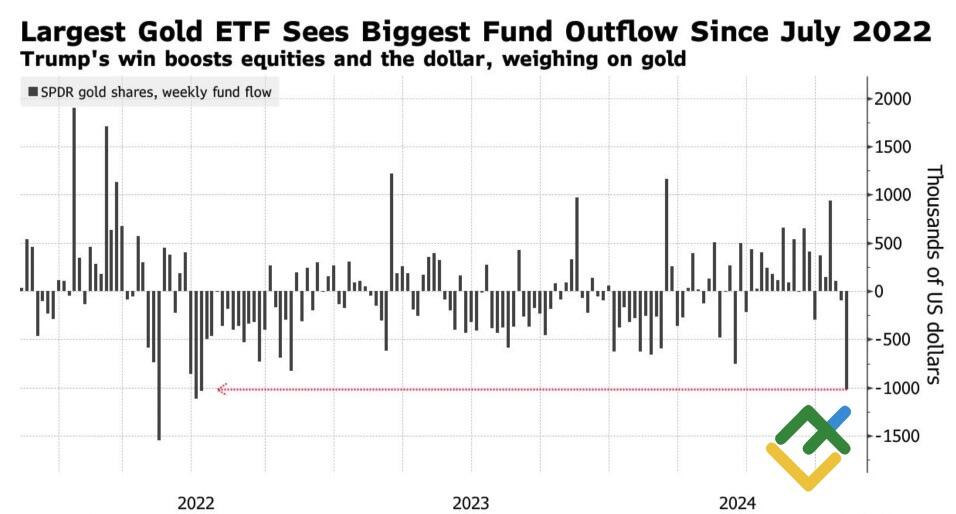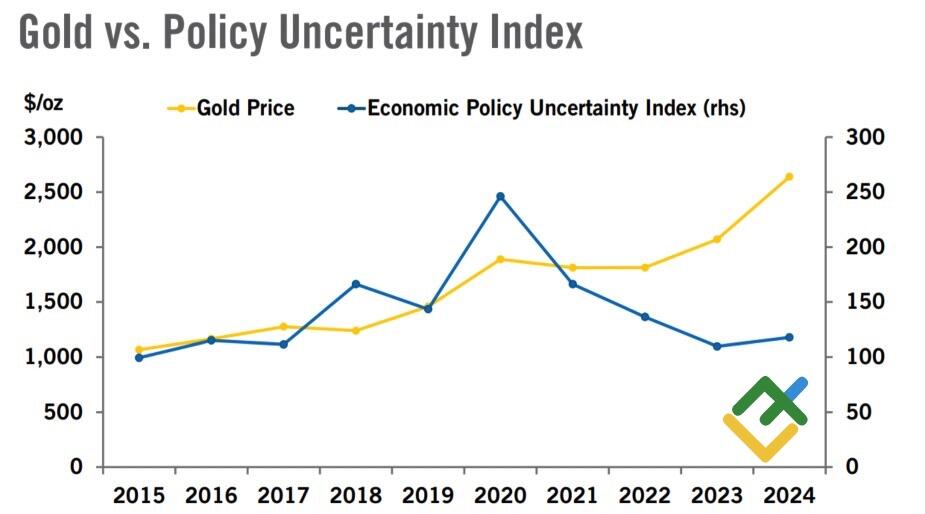
Gold was previously regarded as a strong contender during the Trump trade but has since undergone a correction. Some attribute this to the growing popularity of Bitcoin, while others cite the strength of the US dollar. However, the reality may lie somewhere between these two perspectives. Let’s discuss this topic and make a trading plan.
The article covers the following subjects:
Major Takeaways
- Gold did not meet the expectations of those engaged in the Trump trade.
- The robust US dollar and rising Treasury yields are pushing XAUUSD quotes down.
- The capital spillover from precious metals to cryptocurrencies is dragging gold prices down.
- Gold is expected to consolidate in the range of $2,450 to $2,650 per ounce.
Monthly fundamental forecast for gold
It is not uncommon for markets to be driven by wishful thinking. Gold was seen as a key beneficiary of the Trump trade. Indeed, other financial instruments are also celebrating the victory, including Bitcoin, the stock market, and the US dollar. Conversely, the precious metal was subject to a series of sell-offs due to concerns about accelerating inflation in the US. This perspective currently dominates the market, although there is more to be considered.
The 7% decline in the XAUUSD from its record high may appear unusual. In the days preceding the election, investors were anticipating a market correction in the event of a victory for Kamala Harris. Donald Trump’s return to the White House represents only a minor pullback due to the implementation of the “buy the rumor, sell the fact” principle. In reality, the outcome was different.
The world’s largest gold-focused ETF, SPDR Gold Shares, recorded a weekly outflow of more than $1 billion, the worst since July 2022. Investors appear to have become more cautious and are mindful of the strong dollar and rising Treasury yields, which have historically pushed the precious metal’s price lower.
SPDR Gold Shares Fund Flow
Source: Bloomberg.
While gold is often viewed as a hedge against inflation, rising prices often prompt the Fed to tighten monetary policy. Consequently, Treasury yields rise, and the US dollar strengthens. In such an environment, the XAUUSD tends to decline.
Investors are divesting precious metals in response to concerns that Donald Trump’s trade and fiscal stimulus policies will further spur inflation. This is particularly relevant given that US consumer prices are forecast to accelerate to 2.6% from 2.4% in October. This reinforces the risk of a Fed pause in January or even December, allowing the US dollar index to rise.
One potential factor contributing to the decline in XAUUSD quotes is the increased investor interest in cryptocurrencies. Bitcoin is viewed as “digital gold,” and its rapid rally has led to capital spillover, which hurt the performance of precious metals.
Donald Trump’s return to the White House removes two key factors that have historically supported gold prices: the de-dollarization of the global economy and central bank purchases. Trump intends to finish the armed conflict in Ukraine, which supported the XAUUSD despite significant headwinds.
Meanwhile, gold is still a viable investment at this time. Its price tends to rise during periods of uncertainty, as was the case during Donald Trump’s first presidential term. It is likely to perform similarly now.
Gold Price and Economic Policy Uncertainty Index
Source: Kitco.
Monthly trading plan for gold
Furthermore, a possible trade war will bring currency wars. A significant competitive devaluation of various currencies will lead to a return of interest to precious metals. In this regard, following a period of consolidation in the range of $2450–$2650 per ounce, gold still has an upside potential. The recommendation is to buy when gold quotes decline.
Price chart of XAUUSD in real time mode
The content of this article reflects the author’s opinion and does not necessarily reflect the official position of LiteFinance. The material published on this page is provided for informational purposes only and should not be considered as the provision of investment advice for the purposes of Directive 2004/39/EC.
{{value}} ( {{count}} {{title}} )
This post is originally published on LITEFINANCE.





